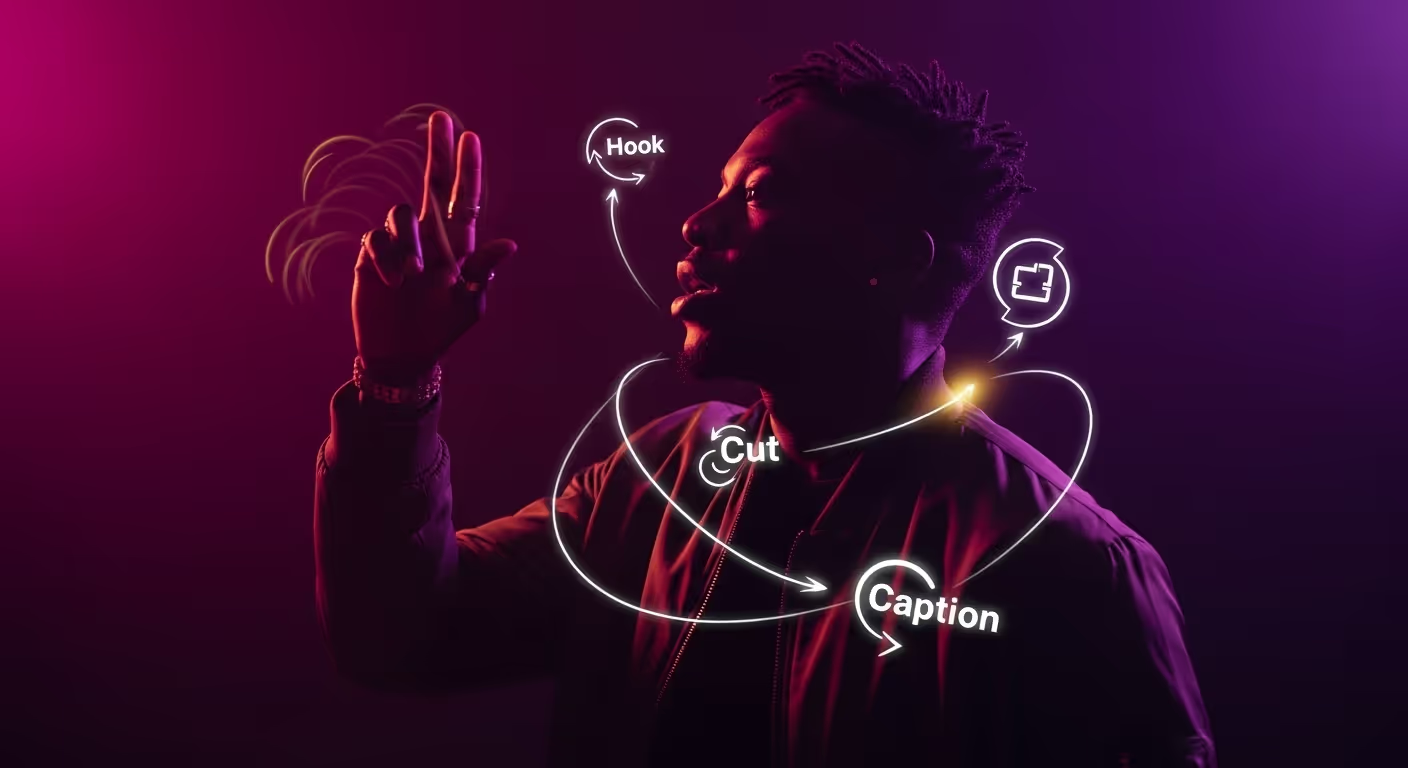
Social
Reels system: hooks, cuts, captions
Make short videos people finish. Use tight hooks, clean cuts, and native captions you can build fast every week.

Why reels matter right now
Short video is the fastest way to earn reach and saves on Instagram and TikTok. The feed favors clips that start strong, move fast, and make a clear point. Good reels are not about fancy cameras. They are about a system you can repeat: hook, cuts, captions. When you keep this simple, you can ship two to three reels per week without burning out.
The core framework: hook, cuts, captions
- Hook: The first line or visual that stops the scroll in three seconds or less.
- Cuts: Quick edits that keep attention without confusion.
- Captions: On-screen text and auto subs so muted viewers can follow.
Everything you do will reinforce these three parts. Plan them before you hit record.
Hooks that win the first three seconds
Hooks work when they promise a result or name a pain in plain words. Keep it short. Speak it in the first beat.
- Stop doing this if you want more [result]
- Three quick fixes for [pain]
- I wasted a week on this so you do not have to
- The fastest way to [task] on [platform]
- One line that doubled our [metric]
Record the hook three times. Punch the key word. Smile or keep a calm face based on your brand. Pick the take that feels natural when played at 1.25x speed.
Cut patterns that keep people watching
Use simple edit patterns you can reuse. Aim for one cut every 1–2 seconds unless the moment needs a linger.
- Jump cuts: Trim pauses between lines so the pace never drops.
- Cut on action: Start the next shot as your hand moves or as you point.
- Insert shots: Drop a close-up of a screen, notebook, or prop to reset attention.
- Beat cuts: If you use music, cut on the beat for rhythm.
Film extra b-roll: hands on keyboard, pointing, flipping a page, nodding. These inserts cover jump cuts and keep flow tight.
On-screen text and captions
Most viewers watch with sound off at first. On-screen text and native auto captions fix that. Keep text large and high contrast.
- Headline text: One to five words for the hook. Place it top or mid frame. Avoid the UI edges.
- Step labels: Short lines like Step 1, Step 2, or Tip 1, Tip 2.
- Auto captions: Use native tools. Check spelling of names and brands.
Do not flood the frame with text. One headline and short labels are enough. Let your voice carry the detail.
Scripts that take ten minutes
Write a tiny script: hook, three points, next step. That is it. Each point is one sentence.
Hook: [line that names result or pain]Point 1: [fast win]Point 2: [common mistake + fix]Point 3: [tool or example]Next step: [save, follow, click]
Read it once out loud. If you stumble, it is too long. Cut words until it sounds like how you speak to a friend.
Angles you can rotate each week
Reels do not need to reinvent the wheel. Rotate a few angles and keep publishing.
- Single tip face to camera: One strong tip with a prop or gesture.
- Over the desk: Point at a printed list or a sticky note plan.
- Before and after: Problem shot, then the fix shot.
- Myth and truth: One myth, one truth, one example.
- Mini case: Metric, timeframe, one action that drove it.
Keep your set simple. A dark backdrop, purple key light, a soft amber rim, and one prop that fits your brand.
Lighting and framing that always work
- Place your key light 45° off center, a bit above eye level.
- Use a rim light or a small lamp behind you for depth.
- Frame mid-chest to head. Leave room for text above your forehead.
- Clean the background. One color wash beats a busy room.
Record in vertical 9:16. Lock exposure and focus so the look stays steady between takes.
Audio that is clean on the first take
- Use a lapel mic or a small shotgun close to your mouth.
- Kill fans and noisy devices. Soft furnishings help.
- Clap once before you start so you can sync takes fast.
Record room tone for five seconds. If you need to smooth cuts later, this helps.
Editing in ten minutes
Keep your edit steps the same every time.
- Drop the best hook take on the timeline.
- Add the three point takes. Trim gaps. Cut on breaths.
- Insert b-roll over rough cuts.
- Add headline text and step labels.
- Turn on auto captions and fix names.
- Export, then upload and set the cover image.
Hooks you can copy
- Three reel mistakes I still see daily
- Do this before you hit record
- The one cut that fixes 90% of boring reels
- My 10 minute script for any topic
- Stop saying this in your first line
What to post each week
Two or three reels a week is plenty when the quality is steady. Use this pattern.
- Mon: Single tip face to camera
- Wed: Over the desk step list
- Fri: Before and after or mini case
Use stories to tease the reel. Add a poll or question sticker after posting to nudge replies.
Captions and CTAs that nudge action
Write short captions with a clear next step. Keep hashtags light and focused.
- First line: Repeat the hook in text form.
- Value line: The tip or result in one sentence.
- CTA: Save for later, share with a friend, or click the link.
Use three to five relevant tags. Stop at that.
Thumbnails and covers
Pick a cover that mirrors the hook. Big words. High contrast. Your face if it fits the brand. Avoid tiny type and busy photos. People should understand the topic in one glance.
Posting time and frequency
Post when your audience is most active. Check insights for peaks. Stay steady. One week does not make a trend. Give each reel two to three days before you judge it.
What to track
- Watch time and completion rate: Do people finish the clip?
- Saves and shares: Strong signs the tip helped.
- Follows and profile actions: Proof your content brings the right people.
- Comments: Log common questions for future reels.
Track per angle: face to camera vs over the desk vs before and after. Double down on the angle that brings saves and follows.
Common problems and fixes
- Dead first second: Start with the hook line already rolling. Trim pre-roll.
- Flat delivery: Stand up. Smile slightly. Punch one key word.
- Messy frame: Clean background. Move props out of the way. Add a small rim light.
- Text too small: Use big type, few words, and safe zones.
- Low sound: Move the mic closer. Record again. Do not post muddy audio.
A 10 minute reel script you can reuse
Hook (3s): "Three reel mistakes I still see daily."Point 1 (7s): "No hook. Start with the result or the pain."Point 2 (7s): "Long pauses. Cut your breaths. Keep pace tight."Point 3 (7s): "Tiny text. Big type and auto captions."CTA (3s): "Save this for your next shoot."
Batching day plan
Make five reels in one hour.
- Write five hooks and tiny scripts (10 minutes).
- Set lights and frame once (5 minutes).
- Record all hooks, then all points (25 minutes).
- Edit two reels now (15 minutes). Save raw clips for later.
- Schedule posts and set reminders for the rest (5 minutes).
Final notes
Reels work when the first line earns attention and the next 20 seconds keep it. Do less. Say it clearer. Use the same framework each time. Hook, cuts, captions. Ship on schedule and track the angles that drive saves and follows. Your output will rise, your stress will fall, and your channel will grow.
read more
Similar articles

Find Anyone Faster with LinkedIn AI Search

Your marketing plan for Sora AI video
Let’s grow
Start your monthly marketing system today
No guesswork, no back-and-forth. Just one team managing your website, content, and social. Built to bring in traffic and results.




